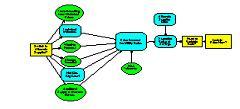
Capital Project Analysis
Capital Project Analysis - Case Study

It's 2008 and most of us probably think that any U.S. citizen or business owner can obtain electric service by simply making a phone call and placing a request with their local utility. Well that's not always the case, and in this month's newsletter we will discuss a recently completed project to demonstrate how challenging that can be for some. It is also our hope that this case study might trigger some thoughts with our readers on how we may be able to assist you with your unique energy management needs.
Client's Challenge and our Solution
Client Description:
A large family-owned ranch grows crops in a remote arid region of the western U.S. In order to grow their crops they must constantly irrigate from a near-by river during the months of March through October.
Challenge:
Due to its remote location, the local electric utility does not provide service at this time. Determine if there is a more economical and reliable alternative for irrigating than using the current diesel generator (DG) sets. DG sets are diesel engines that drive a generator to produce electricity. The generator is then used to power electric motors that run their irrigation pumps.
Resolution:
- Many solutions where considered, including an array of other distributed generation options, alternate fuel sources, and staying with the current system.
- The decision was finally narrowed down to 2 choices. Stay with the DGs or build a substation and line extension and take electric service from the local utility.
- If an electric line extension is made, the irrigation pumps will be powered from the utility and the DG sets will be used as emergency backup (if an interruptible rate is selected) or sold for salvage value.
- The ranch owner obtained all necessary siting permits and a preliminary cost estimate for building the 16-mile line extension.
- Since the rancher is the only customer requesting the line extension, he will pay for the entire cost over a 15-year period. Our review of the utility tariff shows that any new customers tying into the extension in the first five years will share in the capital cost. None are known at this time and our conservative analysis assumed that none will be available to help defray the cost.
- Independent Energy Consultants analyzed the rancher's electric consumption (energy, demand, power factor, load factor, time of use, power quality, etc.) and the local utility's rate structure.
- The would be electric operating costs were then compared to the fuel and maintenance costs of running the DGs. The analysis also considered the efficiency and reliability of the two options.
- The optimal rate schedule from the local utility was identified and it was determined that a 7-year project payback was needed. In other words, in 7-years the electric bills paid to the utility would be sufficiently lower than the DG fuel and maintenance costs to overcome the capital cost of building the line extension.
- The family-owned ranch is expected to be operating for many years to come, and the electric line extension project is likely to move forward.
- Finally, the utility company offers incentives to help finance solar panel projects in this area of the country. Independent Energy Consultants was asked to analyze the cost and of that option in conjunction with the line extension. Our analysis showed that even with discounts on solar panels, there were many other lower cost alternatives for self generation of electricity.
Are you Faced with a Capital Project Decision?
If you're faced with having to make an energy-related decision, Independent Energy Consultants can help guide you through a methodical process. We will even arm you with tools allowing you to perform your own "scenario analysis". A robust analysis should incorporate uncertainty in the variables (e.g., fuel costs, energy consumption, etc.) that drive your costs/savings - enabling you to see a range of possible outcomes. A thorough analysis will also identify the "break points" that would change your selection of decision alternatives.
Please contact us if you would like to discuss the proper analysis of your potential capital projects.
If you have already performed an energy efficiency project and would like to independently verify the resultant savings we can help with that as well. Please refer to our November 2006 newsletter that discusses Verification of Avoided Costs.



